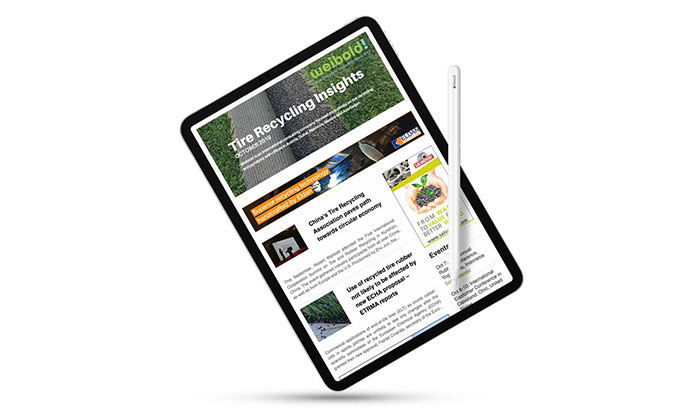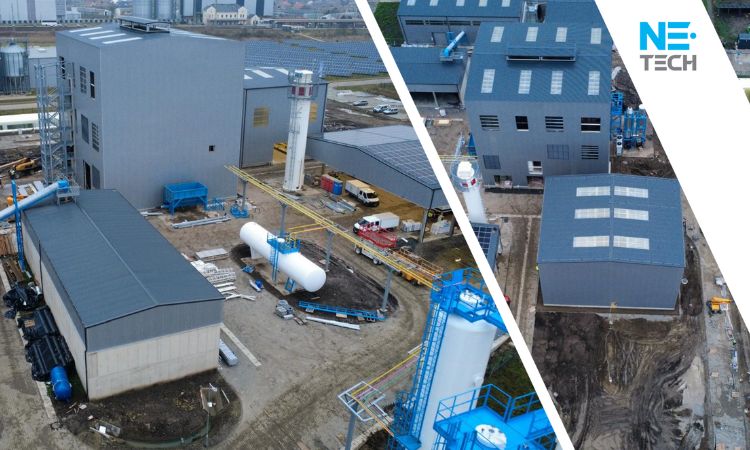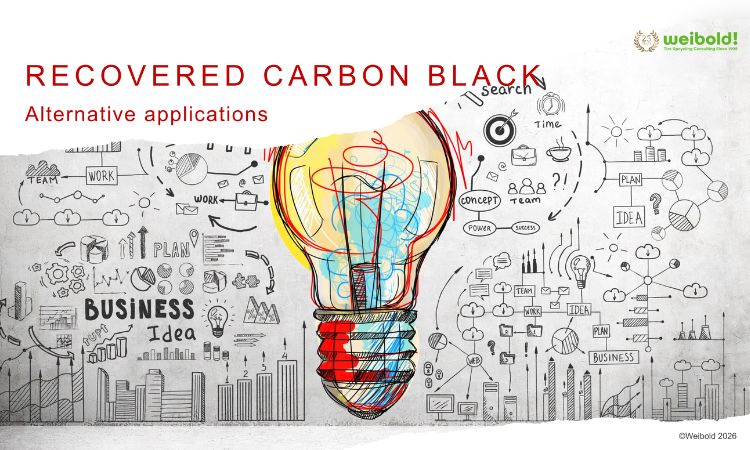Weibold Academy: ELT Pyrolysis - a Best Available Technology (BAT)
Weibold Academy article series discusses periodically the practical developments and scientific research findings in the end-of-life tire (ELT) recycling and pyrolysis industry.
This article is a review by Claus Lamer – the senior pyrolysis consultant at Weibold. One of the goals of this review is to give entrepreneurs in this industry, project initiators, investors and the public, a better insight into a rapidly growing circular economy. At the same time, this article series should also be a stimulus for discussion.
For the sake of completeness, we would like to emphasize that these articles are no legal advice from Weibold or the author. For legally binding statements, please refer to the responsible authorities and / or specialist lawyers.
Introduction
The best available technology (BAT) is the technology approved by legislators or regulators for meeting output standards for a particular process. BAT for a given industrial sector is described in reference documents called BREFs (Best Available Techniques Reference documents). BREFs are the result of an exchange of information between European Union Member States, the industries concerned, non-governmental organizations promoting environmental protection and the European Commission. This exchange of information is referred to as the Sevilla process because it is steered within the Institute for Prospective Technological Studies of the European Commissions' Joint Research Centre, which is based in Seville. The process is codified into law by Commission Implementing Decisions. The most important chapter of the BREFs, the BAT conclusions, are published as implementing decisions of the European Commission in the Official Journal of the European Union. According to the Industrial Emissions Directive (IED), the BAT conclusions shall be the reference for setting permit conditions of (large) industrial installations.
In the United States, BAT or similar terminology is used in the Clean Air Act and Clean Water Act. The Clean Air Act Amendments require that certain facilities employ Best Available Control Technology to limit emissions. The Clean Water Act (CWA) requires issuance of national industrial wastewater discharge regulations (called "effluent guidelines"), which are based on BAT and several related standards. In the development of the effluent standards, the BAT concept is a "model" technology rather than a specific regulatory requirement. The U.S. Environmental Protection Agency (EPA) identifies a particular model technology for an industry, and then writes a regulatory performance standard based on the model. The performance standard is typically expressed as a numeric effluent limit measured at the discharge point. The industrial facility may use any technology that meets the performance standard.
International conventions for ELT management
The parties to the Basel Convention (United Nations Environment Programme; UNEP) on the Control of Transboundary Movements of Hazardous Wastes and Their Disposal have considered the difficulties involved in identifying and managing end-of-life tires (ELT), given their potential harmful effects on human health and the environment. Accordingly, technical guidelines for identifying and managing ELTs were prepared. They were adopted by the Conference of Parties to the Convention by its decision V/26, with the first version published in October 2000 and reissued in November 2002.
In the seven years that followed the publication of these guidelines, additional knowledge and experience in handling ELTs was gained in many countries, and attention turned to technological, economic, and environmental factors broader than those discussed in the original version of the guidelines. Consequently, the Conference of the Parties adopted decision VIII/17 with a view to revising and updating the guidelines, to assist national authorities in the environmentally sound management of ELTs within their national territories.
The revised technical guidelines provide guidance for the environmentally sound management (ESM) of ELTs – including ELT pyrolysis - in accordance with decisions VIII/17, IX/14 and BC-10/6 of the Conference of the Parties to the Basel Convention and VI/3 and VII/6 of the Open-ended Working Group of the Basel Convention.
As part of the follow-up conference to improve the effectiveness of the Basel Convention, the United Nations published a revised draft factsheet on specific waste streams on February 16, 2017, which also includes the environmentally sound management of ELTs and specifically refers to the still valid technical guidelines from 2011 (published 2013).
Best Available Technology
Since pyrolysis in general is legally wrongly classified as "incineration" in the European Union (due to the exclusion of oxygen during pyrolysis, it cannot be an "incineration process"!), this recycling technology can be found in the current Best Available Techniques Reference Document for Waste Incineration (BREF).
On page 60 (of 764!) there is the reference to tire pyrolysis ("pyrolysis processes are also used for ... used tyres"). The (potential) advantages of pyrolysis processes are also listed:
- the possibility of recovering the material value of the organic fraction (TDO and rCB)
- the possibility of increased electrical generation using gas engines or gas turbines for generation
- reduced flue-gas volumes after combustion (co-incineration of the incondensable pyrolysis-gas providing the necessary energy for the pyrolysis process)
- the possibility of meeting specifications for external use of the produced char (rCB)
It is noteworthy (and correct) that the United States Environmental Protection Agency (EPA) has recognized this erroneous classification of pyrolysis as “Waste Incineration” (which is therefore not unique to the EU) and only recently (2021) proposed to revise the definition of ‘‘municipal waste combustion unit’’ by removing the reference to ‘‘pyrolysis units’’ from this definition (ANPRM).
This EPA perspective is not new, since in the USA, ELT pyrolysis systems are already explicitly excluded from the definition as municipal waste combustion unit in current federal law (40 CFR 60.1465).
EPA has learned that pyrolysis units are nowadays used to „convert solid waste (e.g. tires) to useful products such as energy, fuels and chemical commodities.“
Already in 2004 the German Federal Environment Agency (UBA) listed ELT pyrolysis in its data sheet "Best Practice Municipal Waste Management" (SWSM-04_TYR) under the heading "Suitable or recommended recycling methods and strategies" for ELT: "Another option for (…) recycling is pyrolysis. The gas can be used as an energy source (...). The pyrolysis oil can be used as a raw material for various products (...)."
Perspectives on End-of-Life Tire (ELT) Management
Formed in 2005, the Tire Industry Project (TIP) is a global initiative that aims to proactively identify and address the potential human health and environmental impacts associated with the life cycle impacts of tires to contribute to a more sustainable future.
Comprising 10 leading tire companies – representing more than 60% of global tire manufacturing capacity – TIP operates under the umbrella of the World Business Council for Sustainable Development (WBCSD). WBCSD work to address sustainability challenges includes contributing to the global state of knowledge on ELT management and efforts to drive improvements in ELT management through information sharing and stakeholder engagement.
To address these themes, WBCSD partnered with Accenture, the US Tire Manufacturers Association (USTMA), the European Tyre and Rubber Manufacturers Association (ETRMA) and the China Tyre Recycling Association (CTRA).
In China, which accounts for more than a third of the global ELT volume with 12 million tons per year, pyrolysis is already one of the most common recycling routes for ELTs and, according to the CTRA, is to be further expanded in the future.
Also in Europe, the ETRMA will cooperate in the debate on chemical recycling in Europe and support initiatives to further develop ELT pyrolysis (and devulcanization).
Weibold’s understanding of the market confirms the same for the USA and India.
Increasing circularity
Pyrolysis is an emerging theme in waste management which has the high potential to contribute to a low carbon, resource efficient and sustainable economy. In enabling the use of end-of-life tires (ELTs) as secondary carbon feedstock to replace fossil resources to produce organic chemicals, it supports efforts to transit carbon intensive industries from the linear to a circular carbon economy.
To date, efforts have predominantly focused on mechanical recycling to recycle ELTs into ‘‘new” (secondary) raw materials without changing the basic chemical structure of the source material. In recent years, chemical recycling (pyrolysis) – with its potential to reduce environmental impacts compared to waste incineration and landfilling via enabling circularity of waste – has been gaining increasing global attention as a complement to mechanical recycling.
A crucial benefit of ELT pyrolysis is resource conservation, with the added benefit of the (high) potential for emissions avoidance and reduction of environmental impacts associated with landfills and incineration. This corresponds to scientific literature which points to the environmental potential of pyrolysis. Significant efficiency and technological advantages over conventional recycling and disposal routes can be seen. This leads to the potential to increase the scope and volume of ELT recycling to meet higher recycling quota for generation of higher-value products without downcycling. It emphasizes the relevance of pyrolysis for the recycling of ELTs.
Conclusion
Although ELT pyrolysis is (still) incorrectly classified as incineration in some places (but is also qualified as Best Available Technique in the same places), it is a fact that ELT pyrolysis is classified as environmentally sound management (ESM) within the framework of the International Basel Convention of the United Environment Program (UNEP) since 2011.
The Best Available Techniques Reference Document (BREF) from the European Union also directly refers to ELT pyrolysis. The content of the advantages of ELT pyrolysis listed there correspond to those that the United States Environmental Protection Agency (EPA) has recognized.
The best strategies for meeting the challenges of roadblocks imposed by inconsistent country-wide and local regulations, regimes, and classifications systems are still emerging. Being aware of the advances and clarifications made at global levels such as the WBCSD and the United Nations UNEP will go a long way as entrepreneurs in the ELT pyrolysis sector prepare their argumentation for state and local authorities.
ELT Pyrolysis is a successfully emerging and increasingly accepted theme in waste management. It has been proven to harbor a high potential in contributing to a low carbon, resource efficient and sustainable economy, and is therefore supported by authorities and industry interest groups alike.
Weibold is an international consulting company specializing exclusively in end-of-life tire recycling and pyrolysis. Since 1999, we have helped companies grow and build profitable businesses.









